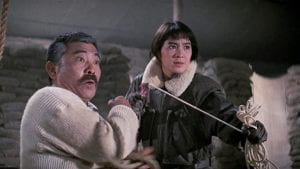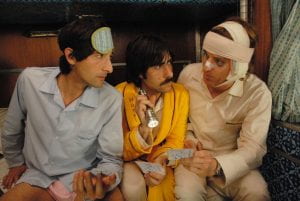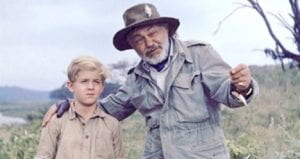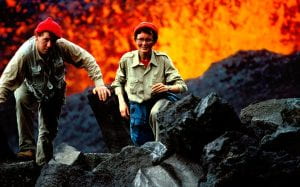Every month, Establishing Shot brings you a selection of films from our group of regular bloggers. Even though these films aren’t currently being screened at the IU Cinema, this series reflects the varied programming that can be found at the Cinema and demonstrates the eclectic tastes of the bloggers. Each contributor has picked one film that they saw this month that they couldn’t wait to share with others. Keep reading to find out what discoveries these cinephiles have made, as well as some of the old friends they’ve revisited.
Ed. note: Establishing Shot will be “dark” throughout July as we perform some maintenance on the blog, but rest assured we’ll be back in August with all of the great, original writing you know and love!
Jesse Pasternack, contributor | Magnificent Warriors (1987)
I have been making my way through the Criterion Channel series “Michelle Yeoh Kicks Ass” for about a month now. So far my favorite of those films, which consists of action movies that she made earlier in her career, is Magnificent Warriors. It expertly combines elements from American adventure films and Hong Kong action movies and features Yeoh playing one of her most dynamic characters. In addition, it boasts incredible fight sequences and brilliantly choreographed setpieces as well as a rousing narrative. All of that helps make it a wonderfully entertaining cinematic experience.
Magnificent Warriors takes place during the 1930s in China. It follows Fok Ming-ming (Michelle Yeoh), a whip-wielding aviator who goes to the city of Kaal to help its residents fight off Japanese soldiers. Once there, she teams up with an intelligence agent (Derek Yee Tung-Sing) and a conman (Richard Ng Yiu-hon) to stop the Japanese military from building a poisonous gas factory.
One of the best aspects about this movie is how it uses some of my favorite things about the Indiana Jones franchise and Hong Kong action movies. Ming-ming is a charismatic adventurer like Jones who uses a whip as a weapon and spends the opening scene involved in an exploit that will have nothing to do with the rest of the plot, just as Jones did in the first three films in which he appeared. But she is also as resourceful and adept at fighting as any of the other characters that Yeoh played in Hong Kong action classics like Royal Warriors (1986) and Yes, Madam! (1985). She also has a great sense of joy about her, like when she uses a gatling gun to destroy a bridge or deals with her adversaries. In addition, the fact that she is a pilot sets her apart from Jones and other characters that Yeoh had played before. Ming-ming is such a memorable character that this film makes you wish that there were many more adventures starring Yeoh as her in which she would fly into a new town in every film to set things right.
Magnificent Warriors contains some of the most entertaining action sequences of Yeoh’s career. The fights between her and a wide array of villains are exciting and feature Yeoh performing exceptional hand-to-hand fight choreography. The filmmakers also have exciting scenes which feature great use of weapons that range from guns to a crossbow. They frequently create spectacles which will be enticing for fans of action movies.
While you might think that Magnificent Warriors has nothing more on its mind than entertaining those who watch it, that is not the case. This film is also a fascinating portrait of people resisting occupation by an invading force and learning how to fight back. A relatively late scene of an aristocrat named Youda (Lowell Lo Koon-Ting) finding his political voice and the solidarity that his people give him is as inspirational as anything in RRR (2022), which covers similar narrative territory.
This film has become one of my favorites starring Yeoh. It expertly combines tropes from two of my favorite types of action films to forge its own interesting identity, complete with incredible action sequences. If you have to see only one of Yeoh’s movies that she made in Hong Kong, try to make it Magnificent Warriors.
Michaela Owens, Editor | The Darjeeling Limited (2007)
After writing about my love for Wes Anderson earlier this month, I thought about staying away from the filmmaker for this round-up, but I just couldn’t do it, not when I’m still thinking about The Darjeeling Limited weeks later after finally seeing it. (I’m also fresh off of seeing his newest, Asteroid City, which I’d highly recommend but still need time to process!)
For the longest time, I’ve been told that this 2007 film about three brothers traveling through India after their father’s death was lower-tier Anderson that looked stunning but wasn’t otherwise that potent. Considering how often I disagree with people’s ideas about the writer/director, I should’ve known to dismiss this characterization and seek out the movie for myself much sooner than I did because let me tell you: The Darjeeling Limited is a freaking delight. It has everything I love about Anderson, including striking visuals and a great soundtrack (any film that begins with The Kinks’ “This Time Tomorrow” and closes with Joe Dassin’s “Les Champs-Élysées” is aces in my book), but I think it also has to be one of the filmmaker’s funniest and most emotionally resonant films. To go from the absurdity of Owen Wilson and Adrien Brody fighting each other on the floor with Jason Schwartzman wielding a can of mace and yelling at them, “I love you, but I’m going to mace you!” to a gut-punch of a flashback that shows the brothers on their way to their father’s funeral, The Darjeeling Limited has immediately become a film that is close to my heart. I might even watch it again tonight.
(If you can find a decent copy of it, you should also check out Hotel Chevalier, Anderson’s short film that takes place before Darjeeling and gives you more of a background on the relationship between Schwartzman’s character and Natalie Portman’s, who only appears in the feature film for a wordless cameo.)
Noni Ford, contributor | The Fire Within: A Requiem for Katia and Maurice Krafft (2022)
Werner Herzog’s documentary The Fire Within: A Requiem for Katia and Maurice Krafft features footage from Katia and Maurice Krafft, two French volcanologists who traveled the world to capture active volcanoes and their aftermaths. While we watch the somewhat beautiful flow of lava that contrasts with the horrifying devastation of the volcanoes, Herzog’s ever distinctive voice leads us through their careers. They were both scientists who dabbled in amateur videography in the early years of their work together. They were both featured, in some capacity, in many of the shorter clips of excursions they took while conducting materials to study, and then they began to remove themselves more from the equation and focused instead on the environments alone.
What we find in this film isn’t a detailed account of each part of the volcanic eruption, although if you’re new to volcanology Herzog does give some background of certain details, but instead a portrait of a married couple tied together by volcanoes. There’s a magnetism to the film they captured, in the ebbs and flows of lava and the falling rocks. It’s almost easy in some way to understand why the Kraffts loved volcanoes so much; as dangerous as it looks, it is somehow, despite it all, beautiful. The ensuing aftermath is less beautiful: they often shot forests that were wiped away, local people scrambling for resources, and towns completely emptied. Yet both pieces are essential to one another and combined form a more complete picture of these natural disasters. Volcanoes are nature at its most ferocious, changing the terrain of an area, and the people who are affected by it show a story of the struggles of humans to live in a world where nature can change everything in an instant. Although they didn’t formerly study documentary creation, their instincts were sharp, and it yielded film pieces that were incredibly moving to see.
Herzog reveals at the beginning that the Kraffts lost their lives in a pyroclastic cloud while filming the eruption of Mount Unzen. While it’s sad to reflect on what other work they could have accomplished had they lived, it appeared that they died doing what they both loved: shooting videos of volcanoes together. This film is not a tragedy, it is a tribute to their work and partnership.
Jack Miller, contributor | Sammy Going South (1963)
One aspect of cinema that has interested me for a while now is the medium’s potential to approximate the subjectivity or vision of childhood — and not only at the level of narrative, as one might encounter in a classic work of children’s literature, but at the level of the film image as well. This form of accessing or conjuring a child’s perception of the world is a rare quality which unites a small and disparate, but very special, group of films, including Charles Laughton’s nightmarish fable The Night of the Hunter (1955), Fritz Lang’s beautiful adventure film Moonfleet (1955), Joseph Losey’s strange post-war allegory The Boy with Green Hair (1948), and Ingmar Bergman’s magnum opus Fanny and Alexander (1982). To this rarefied selection one could also add Sammy Going South (1963), a neglected late film by the great Alexander Mackendrick, an American-born director who is best remembered today for a series of Alec Guinness comedies he did at Ealing Studios in the UK and for his aggressively stylized noir Sweet Smell of Success (1957).
Sammy Going South tells of the journey of an orphaned boy (Fergus McLelland) who loses his parents in an air raid in Suez Port and proceeds to walk across the entire continent of Africa on foot to reach an unknown aunt in distant South Africa. Along the way, he encounters various characters, both benign and wicked, of different social classes and backgrounds, and forms a strange friendship with an old, grizzled diamond smuggler played by the great Edward G. Robinson. Part of what makes the film special is that, unlike most children’s movies, Mackendrick doesn’t lean into the inherent sentimentalism of the story but rather undercuts it at every turn, emphasizing instead the sense of danger and loss that Sammy faces. The film was magnificently shot in CinemaScope by Erwin Hilier, and Mackendrick and Hilier make the most of the widescreen format by detailing the harshness and consequences of the natural landscape. The film was cut by nearly 40 minutes for its American release in 1963 and retitled A Boy Ten Feet Tall, both of which probably contributed to it getting widely ignored. Though the film hasn’t been released on home video here in the US, there’s a good print of it on YouTube which preserves its original widescreen aspect ratio. It’s a beautiful movie that deserves to be resurrected from the dustbin of film history.
And if my recommendation isn’t enough, here’s a video of filmmaker Joe Dante recommending the film on Trailers from Hell.



